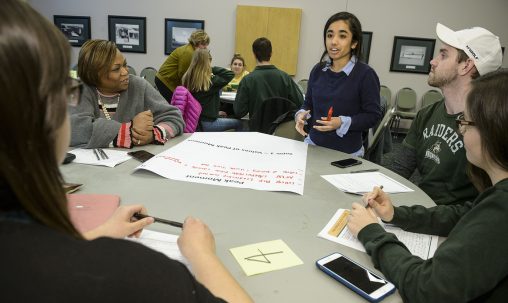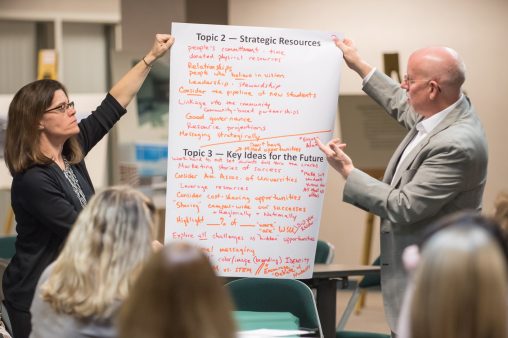
More than 100 Wright State community members and partners are expected to attend a stakeholder summit to discuss the university’s mission and values, strengths, aspirations and action items and goals to include in the strategic plan.
Representatives from throughout the Wright State University community will discuss the university’s mission and values and identify goals for the strategic plan during a three-day summit this week.
More than 100 Wright State community members and partners are expected to attend a stakeholder summit on March 20–22 at 2455 Presidential Drive, the future home of the Wright State Archives Center.
Participants were invited by the Strategic Planning Steering Committee to represent a broad perspective of all Wright State stakeholders. The summit will bring stakeholders together to talk through elements that will make up the strategic plan, The Wright Path to 2025: Pride, Transformation, Potential.
“Working together we can accomplish a lot. Everyone is witness to how the process evolves,” said David Bright, co-chair of the Strategic Planning Steering Committee and chair of the Department of Management and International Business.
Discussions held during the summit will build off the input gathered during nine community dialogue sessions that were attended by more than 300 students, faculty, staff, students, alumni and community partners over the last six weeks. During the dialogues, participants shared stories exemplifying moments of success they or others experienced at Wright State, identified the values those experiences represent and brainstormed actions that could impact Wright State’s future.
“The ideas and aspirations shared by those who have participated in our strategic planning process have truly been invaluable,” said Wright State President Cheryl B. Schrader. “I am also impressed by the enthusiasm people have expressed in this process. By engaging deeply in community discussions, we can work collectively to realize our hopes and dreams.”

Discussions held during the summit will build off the input gathered during nine community dialogue sessions that were attended by more than 300 students, faculty, staff, students, alumni and community partners
By the end of the summit, the Strategic Planning Steering Committee expects to have a clear picture of what the community thinks are Wright State’s core values and mission. The committee will use that input to revise the university’s vision, mission and values statements.
In April, the steering committee will host an event to unveil the updated vision, mission and values statements and a draft strategy statement.
Stakeholder summit participants will also identify Wright State’s areas of strength, opportunities for the future and actions that can translate into specific goals in the strategic plan. Volunteers will be assigned to work in groups to refine the goals in the strategic plan, develop action items for each goal and create metrics to measure each goal.
“When we’re done, the strategic plan will be a collectively generated document,” Bright said.
The strategic plan will guide Wright State by creating a vision and focus that directly aligns resources with the community’s values, strengths and the strategy built around them. The planning process will be continuous and will put Wright State in a position to thrive in higher education’s changing environment, help the university achieve financial sustainability and foster a campus atmosphere that provides graduates with opportunities to excel in fields that define the future.
The goal is to deliver a strategic plan to the Board of Trustees by October 2018 for its approval.

After the summit, participants will work in groups to refine the goals in the strategic plan, develop action items for each goal and create metrics to measure each goals.
The Strategic Planning Steering Committee is guiding the university’s efforts to include a wide range of perspectives from the Wright State family and the broader community. The committee includes 33 Wright State employees, students and alumni as well as community leaders. It is co-chaired by President Cheryl B. Schrader; Michael Wiehe, director of the Applied Policy Research Institute; and Bright.
The planning process will continue after the strategic plan is complete, and it will regularly be revisited and adjusted based on the community’s continuous input. The strategic planning process is intended to start an ongoing dialogue among the campus community that encourages continuous reflection and revision of the community’s hopes and priorities.
You can stay up to date with the planning process by visiting wright.edu/strategicplan.

 Wright State University Foundation awards 11 Students First Fund projects
Wright State University Foundation awards 11 Students First Fund projects  Gov. DeWine reappoints Board Treasurer Beth Ferris and names student Ella Vaught to Wright State Board of Trustees
Gov. DeWine reappoints Board Treasurer Beth Ferris and names student Ella Vaught to Wright State Board of Trustees  Joe Gruenberg’s 40-Year support for Wright State celebrated with Honorary Alumnus Award
Joe Gruenberg’s 40-Year support for Wright State celebrated with Honorary Alumnus Award  Wright State’s elementary education program earns A+ rating for math teacher training
Wright State’s elementary education program earns A+ rating for math teacher training  Wright State’s Calamityville hosts its largest joint medical training operation
Wright State’s Calamityville hosts its largest joint medical training operation 